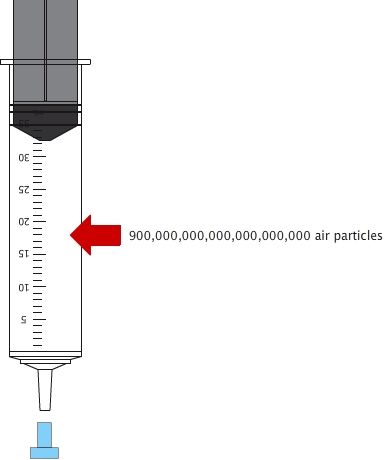What Is Air?
So let’s return to our syringes. Is there anything inside them? When you take off the blue cap and pull the plunger up to 35, the barrel of the syringe is actually filled with air. You can’t see it, but it’s there and its presence does affect how the syringe behaves. We really won’t be able to understand the behavior of syringes unless we consider the air inside them.
Air is a mixture of gases. It’s considered a mixture because you can’t point to a single particle and say, “That’s an air particle.” If you were able to zoom in on air, you would see that air is really made up of many different types of particles. These particles include nitrogen (N2) molecules, oxygen (O2) molecules, water (H2O) molecues, argon (Ar) atoms, carbon dioxide (CO2) molecules, and small amounts of other particles. You’ll learn more about atoms and molecules next year. For now, we are going ignore the fact that air is made up of many different types of particles and just think of them all as “air particles.”
If you were to take off the blue cap and pull the plunger up to 35, how many air particles do you think would be inside the barrel of the syringe? The answer is approximately 900,000,000,000,000,000,000 air particles. And those air particles are in constant motion, moving at an average speed of about 700 mph at room temperature (particles move faster when the temperature is higher and slower when the temperature is lower).

If we wanted to represent the air particles inside of our syringe, how could we do it? Well, we could do it by drawing 900,000,000,000,000,000,000 dots inside of the syringe. But if we drew 10 dots per second, it would take us nearly three trillion years to draw them all.